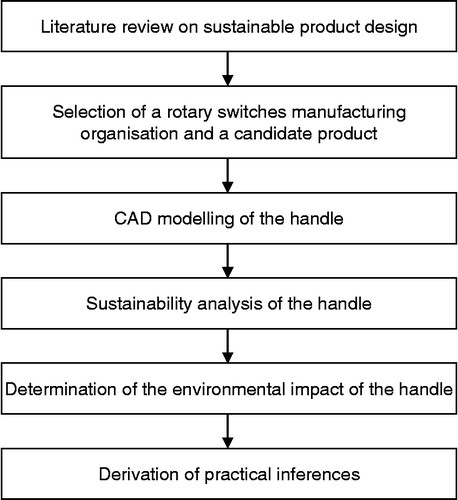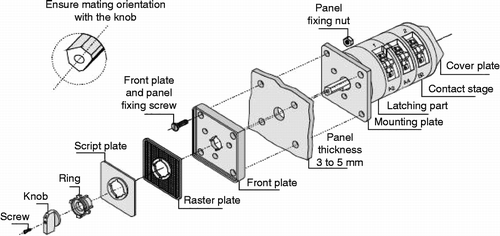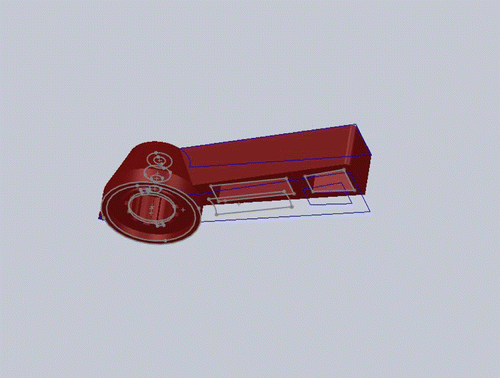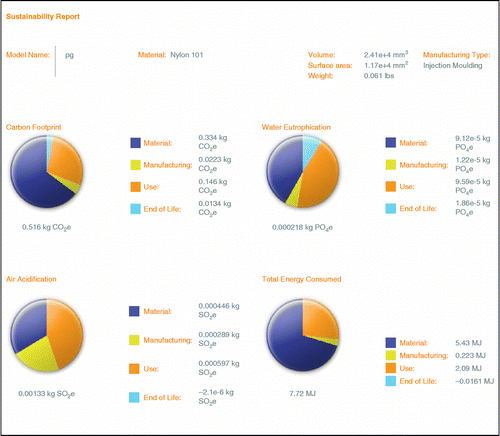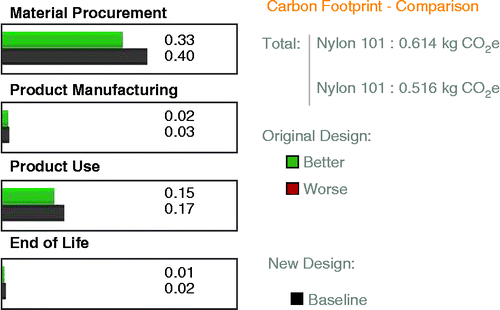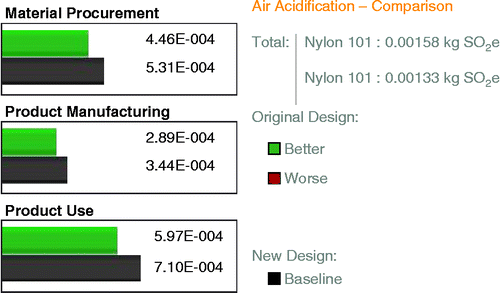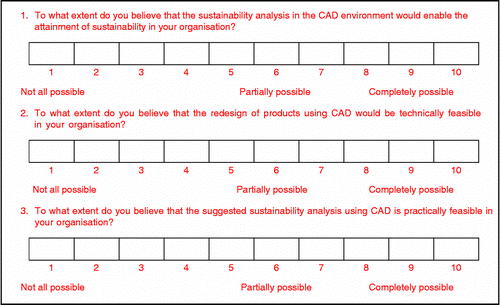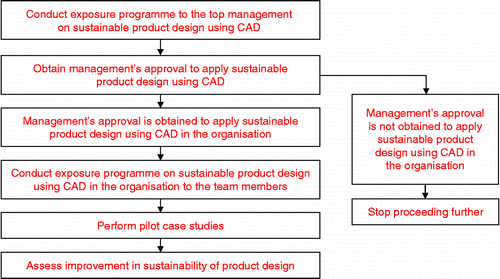Abstract
Sustainability is gaining importance in contemporary manufacturing organisations. Modern design engineers need approaches for creating environmentally friendly products. In this context, this paper reports a case study carried out in an Indian rotary switches manufacturing organisation. A component of the rotary switch has been modelled using computer-aided design. Then, the sustainability analysis has been carried out for determining the environmental impact. The environmental impact has been measured in terms of carbon footprint, energy consumption and air/water impacts. The handle design has been modified to minimise the environmental impact. The results of this case study indicate that appropriate modifications in design could lead to the development of sustainable design with minimal environmental impact.
1. Introduction
Growing businesses recognise sustainability as an important concept for survival in the competitive market scenario (Bevilacqua et al. Citation2007). Environmental, economic and competitive market conditions stress sustainable design, a desirable approach for contemporary organisations (Senthilkumaran et al. Citation2001). Modern designers need tools that automate and simplify material decisions due to the ever-increasing cost and regulatory issues complicating options of materials and geometry. Sustainable design is a comprehensive, holistic approach for creating products and systems that are environmentally benign, socially equitable and economically viable. It implies that the design should be such that it offers measurable environmental benefits, fills the needs of everyone involved in its production, use and disposal or reuse, and is competitive in the market scenario. The practical aspects of sustainable design involve minimal material usage, improved material choices, design for ease of disassembly, product reuse, minimal energy consumption, manufacturing without producing hazardous waste and the usage of clean technologies. In this context, this paper reports a case study of ensuring sustainable design of a component ‘knob’ manufactured by an Indian rotary switches manufacturing organisation using computer-aided design (CAD). The objective of this paper is to ensure sustainable product design using CAD. The sustainability analysis has been conducted in the CAD environment. This case study begins with CAD modelling of the knob followed by sustainability analysis to determine the carbon footprint, energy consumption and air/water impacts in a product design's raw material sourcing, manufacturer's use and disposal. The environmental impact of the product design is assessed. Since the sustainability analysis has been carried out in the CAD environment, it facilitates the ease of generation of environmental impact results. The generation of environmental impact results facilitated the redesign of the handle in an effective manner. If this process had been conducted using a manual process, it might have consumed significant amount of cost and time. Sustainable product design using CAD facilitated the organisation to achieve business benefits such as reduced cost and time which would in turn improve the profitability.
2. Literature review
The literature has been reviewed from the perspective of sustainable product design. Gungor and Gupta (Citation1999) have presented the concept of environmentally conscious manufacturing and product recovery (ECMPRO). ECMPRO involves integrating environmental thinking into new product development including design, material selection, manufacturing processes and delivery of the product to consumers, as well as the end-of-life (EoL) management of the product after its useful life. Senthilkumaran et al. (Citation2001) have presented the life-cycle environmental cost analysis (LCECA) model to include eco-cost into the total cost of the products. The LCECA model identifies the feasible alternative for cost-effective, eco-friendly parts/products. This mathematical model of LCECA defines the relationships between the total cost of the products and the various eco-costs concerned with the life cycle of the products. Kaebernick et al. (Citation2003) have presented the integration of environmental requirements throughout the entire lifetime of a product. They presented the concept of an approach to product development, based on a paradigm for sustainable manufacturing. Four examples of methodologies and decision tools are discussed, representing the most important sources of environmental impacts of a product. The emphasis lies on the integrating concept rather than on the details of the methodologies. Park and Seo (Citation2003) have presented a new appropriate LCA methodology for the product concept by grouping products according to their environmental characteristics and by mapping product attributes into the environmental impact driver index. The relationship is statistically verified by exploring the correlation between the total impact indicator and energy impact category. Then, a neural network approach is developed to predict an approximate LCA of grouping products in the conceptual design.
Nagel and Tomiyama (Citation2004) have presented ‘design of the environment’ in the context of the design of the manufacturing systems. They have outlined the air emission and waste profile of 25 manufacturing systems of printed boards. They have presented a concept that when a manufacturing system uses less resource and generates less waste and emissions and the environmental balance is measured and managed with information technology, the system becomes sustainable and intelligent. Anityasari et al. (Citation2005) have presented the concept of reuse of old products as the most environmentally friendly strategy. They have presented an integrated technical and economic model to evaluate the reusability of the products. In order to handle uncertainties, the Monte Carlo simulation is utilised. Lee et al. (Citation2006) have presented a conceptual framework for managing the EoL information and design information in the assistance of designing products with better environmental performance from a system's perspective. They formalised and structured integrated manufacturing and product service system to close the product's life-cycle management loop for easier information sharing with design stage.
Ijomah (Citation2007) have presented a process of bringing used products to a ‘like-new’ functional state, with warranty to match being regarded as a vital strategy in waste management and environmentally conscious management. They presented an outline of the elements of the remanufacturing concept to improve the robustness of design-for-remanufacturing. Rusinko (Citation2007) has presented an exploratory study of the relationship between the specific environmentally sustainable manufacturing practices and specific competitive outcomes in a US-based commercial carpet industry. Sita and Subramania (Citation2007) have presented the concept of using the limits between the business functions of a manufacturing enterprise and the environmental dimensions of the businesses of a simplified service-oriented software model to deliver information on the life-cycle environmental impacts of manufacturing products. Chen and Wang (Citation2008) have presented the CIMSMINER that combines the data mining with computer-integrated manufacturing systems (CIMS) and instructs its objectives, model, physical architecture and methods. Considering the characteristics of remanufacturing of automotive products, the CIMSMINER has been used to derive the information concourse together and obtain the data mining results to enable the improvement of products. Gehin et al. (Citation2008) have presented a strategy called EoL to assess the product EoL process, which would be profitable for an enterprise given the business model in place. They integrated constraints from EoL strategies into the early phases of design as an important aspect that needs to be improved by combining this idea with the principles from concurrent engineering to develop design aids which permits designers to compare their products to ‘remanufacturable product profiles’. Daniel and Hesamedin (Citation2009) have developed a concept called life-cycle phase (LCP) families, to develop reference ranges for the environmental impact of new products as benchmarking with previous environmental information, and proved that LCA is useful in comparing the environmental impact of alternatives, LCP or parts in a product. The proposed concept develops a new product which can be catalogued as environmentally better or worse than a percentage of its competitors, depending on what position it occupies in its LCP family.
The research gap observed based on the literature review is that though many researchers have contributed to sustainable product development approaches, very few have analysed from the viewpoint of CAD. When the sustainability analysis is conducted in the CAD environment, it enables the determination of the environmental impact of a product in an effective manner. In this context, this research project has been carried out.
3. Research methodology
The methodology followed in this project is shown in Figure .
As shown, the project begins with the literature review on sustainable product design. Based on the literature review, the need for conducting the sustainability study in the CAD environment is realised. Then, the appropriate manufacturing organisation is selected and the candidate product is selected as the handle. Next, the CAD modelling of the handle is performed using the Pro/Engineer (Pro/E) package. This is followed by the conduct of sustainability analysis of the handle in the CAD environment. The environment impact of the handle is assessed. This is followed by the redesign of the handle based on appropriate dimensional modifications on the basis of sustainability results. Again, the sustainability analysis is conducted to determine the environmental impact. This is followed by the conduct of practical inferences.
4. Case study
This section presents the details about the case company, product, CAD modelling of the handle and sustainability analysis of the handle.
4.1 About the case company
The case study has been carried out in an electronic switches manufacturing organisation located in Coimbatore, India, hereafter referred to as ABC. They are the manufacturers of cam-operated rotary switches. The organisation has implemented world-class strategies such as ISO 9001:2000 Quality Management System, 5S, Kaizen, TQM, etc.
4.2 About the product
The schematic of the rotary switch is shown in Figure .
As shown, the switch consists of eight parts. All the operating components are contained in the mounting assembly. This consists of mounting plate, latching and contact sub-assemblies. The contact sub-assembly consists of the cam and contacts for enabling the making or breaking or diverting of the circuit. The latching assembly consists of a component called latching star, which is controlled by four springs. This component is shaped to suit the customers' requirement on the opening/closing interval of the circuit. The mounting sub-assembly consists of a mounting plate and other accessories required for operating latching and contact sub-assemblies. The mounting plate mounts the components, namely panel, front plate, raster plate, script plate, ring and knob. Above all, the mounting plate bridges the external and internal operating components through the knob shaft. The knob shaft should possess adequate shear strength to withstand the torque generated while the customer swivels the knob/handle to open and close the circuits at the specified intervals. The ring holds together the script and raster plates and gets assembled with the front plate.
4.3 CAD modelling
The handle of the rotary switch has been modelled using the Pro/E package and is shown in Figure .
The reason for selecting Pro/E for CAD modelling is as follows: Pro/E is incorporated with a boundary representation type of solid modelling approach which supports parametric design. Pro/E makes use of parametric design, which is a powerful tool for undertaking CAD modelling (Chen and Wu Citation1994).
4.4 Sustainability analysis
The sustainability analysis has been carried out using sustainability module of SolidWorks software package. This is the widely used sustainability analysis package. The package is provided with the knowledge base for performing sustainability analysis. The package accepts the CAD model of the product as input and it generates the results of the environmental impact. The material has been specified as nylon. The volume, surface area and weight are computed. The manufacturing process has been specified as injection moulding. Figure shows the results of sustainability analysis. Four important environmental parameters considered in the sustainability analysis are carbon footprint, air acidification, total energy consumed and water eutrophication.
Air acidification represents sulphur dioxide, nitrous oxides and other acidic emissions to air that cause an increase in the acidity of rainwater, which in turn acidifies lakes and soils. These acids can make the land and water toxic for plants and aquatic life. Acid rain can also slowly dissolve man-made building materials such as concrete. This impact is typically measured in units of either kg sulphur dioxide equivalent (SO2e) or moles H+ equivalent.
Carbon footprint represents carbon dioxide and other gases which result from the burning of fossil fuels accumulated in the atmosphere, which in turn increases the earth's average temperature. Carbon footprint acts as a proxy for the larger impact factor referred to as global warming potential. Global warming is blamed for problems such as loss of glaciers, extinction of species and more extreme weather, among others.
Total energy consumed is a measure of the non-renewable energy sources associated with the product's life cycle in units of megajoules. This impact includes not only the electricity or fuels used during the product's life cycle, but also the upstream energy required to obtain and process these fuels, and the embodied energy of materials which would be released if burned. The total energy consumed is expressed as the net calorific value of energy demand from non-renewable resources (e.g. petroleum, natural gas, etc.). Efficiencies in energy conversion (e.g. power, heat, steam, etc.) are taken into account.
Water eutrophication represents over-abundance of nutrients added to a water ecosystem, resulting in eutrophication. Nitrogen and phosphorous from waste water and agricultural fertilisers cause an over-abundance of algae to bloom, which then depletes water of oxygen and results in the death of both plant and animal life. This impact is typically measured in either kg phosphate equivalent (PO4e) or kg nitrogen (N) equivalent.
5. Results and discussion
Sustainability analysis measures the environmental impact over the life cycle of the handle in terms of carbon footprint, air acidification, total energy consumed and water eutrophication.
Figures show, respectively, the carbon footprint, water eutrophication, air acidification and total energy consumed for different phases of life cycle such as material procurement, product manufacturing and product use. As shown, the carbon footprint, water eutrophication, air acidification and total energy consumed have been reduced in the modified design when compared to the baseline design. It can be inferred that by making appropriate design modifications, the environmental impact can be reduced, thereby making the design sustainable. The conduct of sustainability analysis in a virtual CAD environment facilitated the redesign of the product, making the product more eco-friendly.
Figure 6 Comparison of water eutrophication among the baseline and new design across the life cycle.

Figure 8 Comparison of total energy consumed among the baseline and new design across the life cycle.
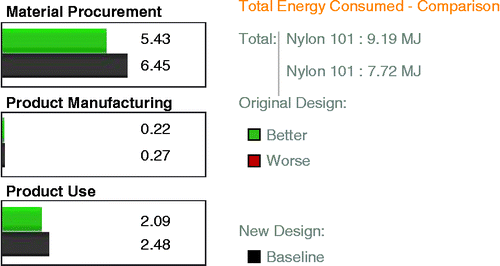
5.1 Practical implications
In order to explore the practical feasibility of deploying CAD for ensuring sustainable product design, a feedback session has been conducted. The format of the questionnaire is shown in Figure .
The responses of the executives are shown in Table . An analysis of the responses indicated that there exists a 90% feasibility of deploying sustainable product design in a CAD environment at ABC.
Table 1 Consolidated responses of the executives.
5.2 Managerial implications
The managerial implications are shown in Figure .
First, the exposure programme has to be conducted to the top management on sustainable product design using CAD. Then, the management's approval has to be obtained to apply sustainable product design using CAD. If the management's approval is not obtained, the procedure has to be stopped. Then, the exposure programme needs to be conducted to the team members. The case study needs to be conducted on a pilot basis. Then, the improvement in sustainability of product design has to be checked.
6. Conclusions
The reduction in production cost and prevention of environmental problems for ensuring clean and green atmosphere is the focus of contemporary manufacturing organisations (Sadiq and Khan Citation2006). A sustainable system tries to maximise resource efficiency for the production of sustained components (Bovea and Wang Citation2007). This case study has been carried out for an Indian rotary switches manufacturing organisation. The handle has been modelled using CAD and sustainability analysis has been carried out. Sustainability analysis measures the environmental impact over the life cycle of the handle in terms of carbon footprint, air acidification, total energy consumed and water eutrophication. This is followed by the redesign of the handle with minimal environmental impact. The practical validation has been conducted to explore the technical feasibility of the redesigned handle design. On the whole, the conduct of sustainable product design using CAD facilitates the organisations to achieve business benefits such as cost and time reduction.
6.1 Limitations and future research direction
The sustainability analysis has been carried out for a single product and for a single manufacturing organisation. Design modification has been carried out by reducing the volume. The optimisation of design has not been carried out. In future, design and topology optimisation could also be carried out for obtaining robust designs. The suggested practice could be carried out for several organisations across different sectors in different countries for deriving much effective practical implications.
References
- Anityasari , M. , Bao , H. and Kaebernick , H. 2005 . “ Evaluation of product reusability based on a technical and economic model: a case study of televisions ” . In IEEE international symposium on electronics and the environment, electronics recycling summit 199 – 204 . New Orleans, LA
- Bevilacqua , M. , Ciarapica , F.E. and Giacchetta , G. 2007 . Development of a sustainable product lifecycle in manufacturing firms: a case study . International Journal of Production Research , 45 ( 18–19 ) : 4073 – 4098 .
- Bovea , M.D. and Wang , B. 2007 . Redesign methodology for developing environmentally conscious products . International Journal of Production Research , 45 ( 18–19 ) : 4057 – 4072 .
- Chen , C.-S. and Wu , J. 1994 . CAD/CAM systems integration: an integrated surface and volume feature modelling scheme . Integrated Manufacturing Systems , 5 ( 4/5 ) : 22 – 29 .
- Chen , K. and Wang , J. 2008 . “ The data mining technology based on CIMS and its application on automotive remanufacturing ” . In Workshop on knowledge discovery and data mining Adelaide, Australia
- Daniel , C.R. and Hesamedin , O.A.G. 2009 . Comparing LCA results out of competing products: developing reference ranges from a product family approach . Journal of Cleaner Production , 15 : 1 – 10 .
- Gehin , A. , Zwolinski , P. and Brissaud , D. 2008 . A tool to implement sustainable end-of-life strategies in the product development phase . Journal of Cleaner Production , 16 : 566 – 576 .
- Gungor , A. and Gupta , S.M. 1999 . Issues in environmentally conscious manufacturing and product recovery: a survey . Computers and Industrial Engineering , 36 : 811 – 853 .
- Ijomah , W.L. 2007 . Development of robust design-for-remanufacturing guidelines to further the aims of sustainable development . International Journal of Production Research , 45 ( 18–19 ) : 4513 – 4536 .
- Kaebernick , H. , Kara , S. and Sun , M. 2003 . Sustainable product development and manufacturing by considering environmental requirements . Robotics and Computer Integrated Manufacturing , 19 : 461 – 468 .
- Lee , H.M. 2006 . “ The framework of information sharing in end-of-life for sustainable product development ” . In IEEE international conference on industrial informatics 73 – 78 . 16–18 August 2006
- Nagel , M.H. and Tomiyama , T. 2004 . “ Intelligent sustainable manufacturing systems, management of the linkage between sustainability and intelligence, an overview ” . In IEEE international conference on systems, man and cybernetics 4183 – 4188 . 10–13 October 2004
- Park , J. and Seo , K. 2003 . Approximate life cycle assessment of product concept using multiple regression analysis and artificial neural networks . KSME International Journal , 17 ( 12 ) : 1969 – 1976 .
- Rusinko , C.A. 2007 . Green manufacturing: an evaluation of environmentally sustainable manufacturing practices and their impact on competitive outcomes . IEEE Transactions on Engineering Management , 54 ( 3 ) : 445 – 454 .
- Sadiq , R. and Khan , F.I. 2006 . An integrated approach for risk-based life cycle assessment and multi-criteria decision-making selection, design and evaluation of cleaner and greener processes . Business Process Management Journal , 12 ( 6 ) : 770 – 792 .
- Senthilkumaran , D. 2001 . Environmental life cycle cost analysis of products . Environmental Management and Health , 12 ( 3 ) : 260 – 276 .
- Sita , R. and Subramania , R. 2007 . “ Business process ontology and software service models for environmentally sustainable manufacturing enterprise ” . In Twenty-ninth international conference on international technology interfaces Cavtat, Croatia
